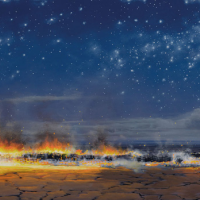15. TIM STORRIER

Essentially my work deals with the infinite; it has got to do with the elements, stars, landscape, fire, water, air.1
One could go further and suggest that Storriers work specifically addresses how humans interact with what is sublime in nature, and our humility in the face of its magnitude. Autumn Night Fire perfectly describes this sensation.
A burning log occupies the foreground sending tiny sparks into the night sky, blending with the stars so that what is a floating ember and what is star becomes almost indistinguishable. A frosty celestial banner stretches across the skys expanse, luminous, perhaps from the light of a hidden moon. The scene is situated in a vast desert landscape, the suggested scale of which intentionally dwarfs the viewer. Lone headlights cross the horizon, emphasising feelings of isolation and distance, and reminding us of humanitys transient impact in these landscapes.
The origin of these epic and desolate landscapes has its roots firmly in Storriers childhood. The artist grew up on a 7,000-acre homestead in rural New South Wales. Expansive landscapes were the backdrop for his childhood games and the spark for his imaginative play. Sent to boarding school at the age of ten, the experience of travelling for hours through the landscape to his new school embedded within him a melancholic association with space and distance. He felt lost and abandoned and would forever after connect these feelings with the experience of being in vast open spaces.2 As an adult he has travelled to places with similarly awesome geography: Antarctica, outback Australia, the deserts of Egypt absorbing the remnants of the Pharaohs and the warning inherent in a civilisation lost to time.
It is worth noting that despite setting up and photographing elaborate constructions, and the photographic perfection of Autumn Night Fire, Storrier does not paint from photographs but from his memory and his imagination.3 In his own words, back in 1987: Whether I am painting a bottle or a sunset, it has more to do with mood, memory and the distillation of time than realism.4 The photographs exist to provide an entry into an unrestricted landscape of the interior, one which allows him to create these sublime elemental paintings.
Footnotes
1. Tim Storrier, quoted in Klepac, L. Tim Storrier, The Beagle Press, Sydney, 2018, p.38
2. Sarks, E., Tim Storrier, Orange Regional Gallery, New South Wales, 1993, p.4
3. Klepac, L., Tim Storrier, p.127
4. Tim Storrier, quoted in Klepac, L. Tim Storrier, p.39
Corinna Cullen, MA (Art History and Curatorial Studies)